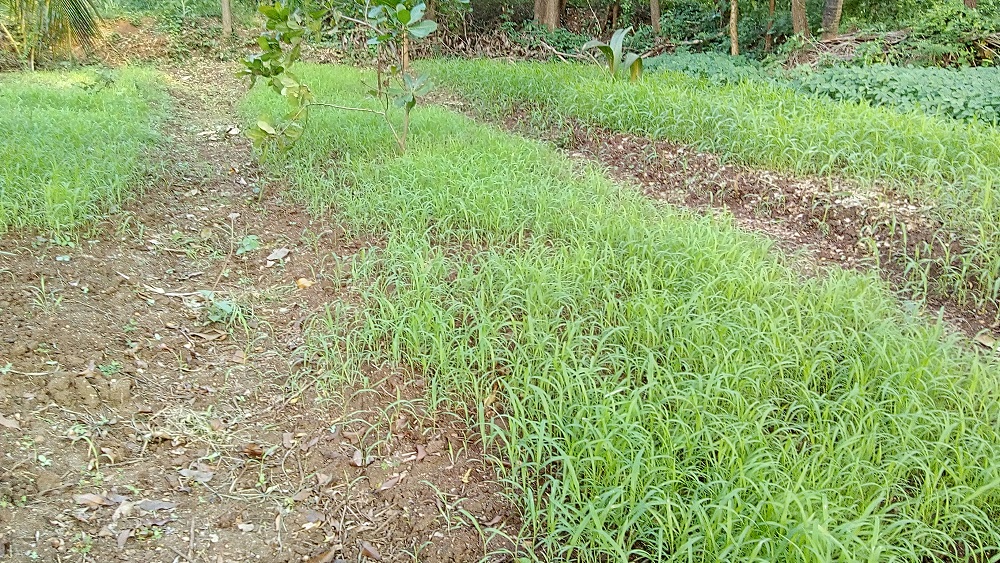Fukuoka san was a complete farmer and he lived like a farmer, his experiences and approach reflect this, so just wanted to bring these points. Lot of people think natural farming is about leave everything to nature, but there is much more than it.
About composting, weeding etc
One straw revolution - Chapter - Humanity Does Not Know Nature
Mr. Fukuoka makes compost of his wood ashes and other organic household wastes. He applies this to his small kitchen garden
One straw revolution - Chapter - Farming Among Weeds
In making the transition to this kind of farming, some weeding, composting or pruning may be necessary at first, but these measures should be gradually reduced each year. Ultimately, it is not the growing technique which is the most important factor, but rather the state of mind of the farmer.
Seeding more pellets
One straw revolution - Farming Among Weeds
Rice is sown 4½ to 9 pounds per quarter acre. Toward the end of April Mr. Fukuoka checks the germination of the fall-sown seed and broadcasts more pellets as needed.
Farming with straw
Mr. Fujii, a teacher at Yasuki Agricultural High School in Shimane Prefecture, wanted to try direct seeding and came to visit my farm. I suggested that he spread uncut straw over his field. He returned the next year and reported that the test had failed. After listening carefully to his account, I found that he had laid the straw down straight and neat like a Japanese backyard garden mulch. If you do it like that, the seeds will not germinate well at all. With the straw of rye and barley, too, if it is spread too neatly the rice sprouts will have a hard time getting through. It is best to toss the straw around every which way, just as though the stalks had fallen naturally.
Straw Helps to Cope with Weeds and Sparrows
I have made a lot of mistakes while experimenting over the years and have experienced failures of all kinds.I probably know more about what can go wrong growing agricultural crops than anyone else in Japan. When I succeeded for the first time in growing rice and winter grain with the non-cultivation method, I felt as joyful as Columbus must have felt when he discovered America
Orchard Earth
This tree was introduced to Japan from Australia some years ago and grows faster than any tree I have ever seen. It sends out a deep root in just a few months and in six or seven years it stands as tall as a telephone pole. In addition, this tree is a nitrogen fixer, so if 6 to 10 trees are planted to the quarter acre, soil improvement can be carried out in the deep soil strata and there is no need to break your back hauling logs down the mountain.
Growing Vegetables Like Wild Plants
The important thing is knowing the right time to plant. For the spring vegetables the right time is when the winter weeds are dying back and just before the summer weeds have sprouted . This method of growing vegetables has been developed by Mr. Fukuoka by trial and experiment in accordance with local conditions. Where he lives there are dependable spring rains, and a climate warm enough to grow vegetables in all seasons. Over the years he has come to know which vegetables can be grown among which weeds and the kind of care each requires.
In most parts of North America the specific method Mr. Fukuoka uses for growing vegetables would be impractical. It is up to each farmer who would grow vegetables in the semi-wild manner to develop a technique appropriate to the land and the natural vegetation.] For the fall sowing, seeds should be tossed out when the summer grasses are fading away and the winter weeds have not yet appeared.
It is best to wait for a rain which is likely to last for several days. Cut a swath in the weed cover and put out the vegetable seeds. There is no need to cover them with soil; just lay the weeds you have cut back over the seeds to act as a mulch and to hide them from the birds
and chickens until they can germinate. Usually the weeds must be cut back two or three times in order to give the vegetable seedlings a head start, but sometimes just once is enough.
Vegetables grown in this way are stronger than most people think. If they sprout up before the weeds, they will not be overgrown later on. There are some vegetables, such as spinach and carrots, which do not germinate easily. Soaking the seeds in water for a day or two, then wrapping them in a little clay pellet, should solve the problem.
Tomatoes and eggplants are not strong enough to compete with the weeds when they are young, and so should be grown in a starter bed and later transplanted
More topics to be covered
Direct-Seeding, No-Tillage Barley/Rice Succession with Green Manure Cover - Natural Farming
Shallow Tillage direct seeding -
Bund preparation....


















































